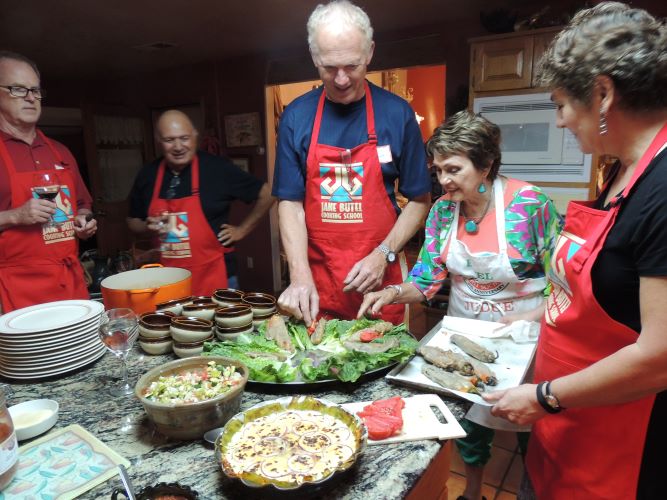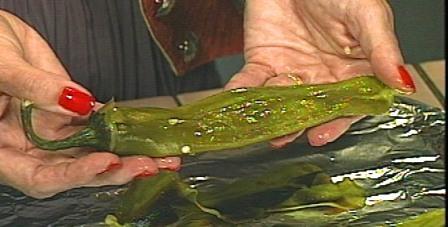Favorite Green Chile Class, Super Special Spice Offer

If you are new to this area--green chile probably sounds a bit weird. Who ever ate or cooked with green chile? Green food other than salad ingredients such as lettuce, spinach or vegetables are the exception. Chili was always red and why is it spelled with an "e" on the end? When there is an "e" on the end, it implies the fruit. Spelled chili is the dish made usually from red chile--and sometimes green.
 The green chile plant is a member of the night shade family of fruits and vegetables. They are called night shades because they always ripen at night. And an unusual quality most people are unaware of is that each chile is an individual and that there can be as large a heat unit spread between chile pods on one plant at a time as 15,000 Scoville heat units. Another interesting fact is that the conformation of each chile tells whether it is hotter or milder. Comparatively speaking, the narrower the shoulder set and the more pointed the tip indicates hotter ones. To a lesser degree, the deeper the coloration--the hotter the chile.
The green chile plant is a member of the night shade family of fruits and vegetables. They are called night shades because they always ripen at night. And an unusual quality most people are unaware of is that each chile is an individual and that there can be as large a heat unit spread between chile pods on one plant at a time as 15,000 Scoville heat units. Another interesting fact is that the conformation of each chile tells whether it is hotter or milder. Comparatively speaking, the narrower the shoulder set and the more pointed the tip indicates hotter ones. To a lesser degree, the deeper the coloration--the hotter the chile.
I will be showing and telling these hints and much more in my class on Thursday, August 7 at 5 PM.
And, if you order any three of our Pecos products, you will get 20% OFF the entire order!
And here is the best way to roast green chilies on your grill or under your broiler. The very best hint is to plunge the chilies as soon as charred in ice water to stop the cooking. They will be much nicer and more nutritious this way!
PARCHING FRESH GREEN CHILES
When you cook with fresh green chiles, I recommend that you parch or roast them to remove the tough outer skin. The process—intense direct heat on the peel of the chile that leaves the flesh uncooked—is easy enough, but if you are not used to the sting of chiles, you may want to wear rubber gloves or generously butter your hands to prevent a burn from the chiles’ irritating oils.
To parch chiles, first wash them, removing all sand and dirt. Leave the stem on, then pierce each one with a sharp knife, about 1 inch down from the stem.
To Parch a Few Chiles: Set up an ice water bath in a large bowl next to the stove. Place each chile directly on a medium-hot electric burner surface unit, or hold it with tongs or a meat fork over a gas burner on medium-high heat. Using tongs, carefully rotate the chiles until the skin is charred on all sides, about about 2 to 5 minutes, then plunge the roasted chiles into the ice bath. Allow the chiles to soak until cool to the touch, then use your fingers to peel away the skin from stem to tip.
To Parch Large Quantities of Chiles: If using an electric oven, cover the entire top rack with heavy aluminum foil and place it four inches from the broiler unit. If yours is a gas oven, cover the broiler rack with foil and place the rack in the closest position to the broiler. (For smaller quantities, cover a baking sheet with foil, and place it on an uncovered rack.)
Preheat the broiler. Or, preheat the outdoor grill to 500 F. Set up an ice water bath in the sink or a very large bowl. When the broiler is hot, carefully place a single layer of chiles on the foil-covered rack or baking sheet and cook until the skin begins to blister on top, about 1 to 2 minutes. Carefully turn the chiles using long tongs or a metal meat fork, and continue to cook until the skins are blistered all over, about 3 to 4 minutes more. Watch the chiles closely—they burn quickly. As soon as the chiles are parched, immerse them in the ice water bath. Once the chiles have cooled to the touch, simply pull off the skin in strips, working from the stem to the tip—it should come away easily.
Keep the stems on if preparing chiles rellenos, or remove them if using the chiles in other ways. For a milder roasted chile, slice open the pods and strip out the seeds and veins with the backside of a knife.
Freezing Parched Chiles
Once you’ve prepared your chiles, you can use them right away or freeze them for later use.
To freeze parched chiles, drain them well after removing them from the ice water bath, then place them on cookie sheets and freeze them (Do not peel the chiles—leaving the skin on now gives you more flexibility of use later) Package the flash-frozen chiles in plastic freezer bags. To use in a recipe, prepare the chiles as needed.
Search Blog
Subscribe to Blog
Categories
Tags
Baking barbecue cookbook Benefits of Pure Chiles blue corn products chii chile and tomatillo seeds Chiles Cinnamon discounted cooking classes Discounted products Flan full particiipation cooking class Hotter Than Hell New Mexican Holiday Favorites Oaxaca Oaxacan recipes pure ground chiles Quick and Easy Recipe week long cooking class weekend cooking class western book© Copyright 2025 All Rights Reserved. TEX MEX Inc. Privacy Policy.
Jane Butel Cooking School • Pecos Valley Spice Co. • Corrales, NM 87048 • Office: 505-243-2622 • info@janebutelcooking.com | Jane Butel Home Page
To ensure delivery of emails from my website please whitelist: info@janebutelcooking.com





